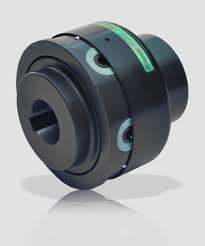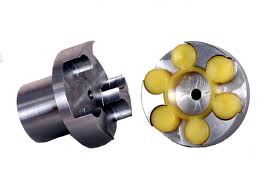Difference between revisions of "Elastic Couplings"
(Created page with "Category:Mechanical Components{{Knoppen}} <noinclude><!------------------------------------------------ * READ THIS FIRST * Only edit this page if you can improve the conten...") |
m |
||
| (One intermediate revision by one other user not shown) | |||
| Line 1: | Line 1: | ||
[[Category:Mechanical Components]]{{Knoppen}} | [[Category:Mechanical Components]]{{Knoppen}} | ||
[[File:Elastic Couplings.jpg|thumb|right|Elastic Couplings]] | |||
[[File:Elastic Couplings1.jpg|thumb|right|Elastic Couplings]] | |||
'''Elastic Coupling''' is a device used for the longitudinal joining of two rotating parts of a machine , designed to compensate for the relative displacement of the parts’ axes and to absorb the shocks caused by joining the parts. The elastic component of the coupling may be made of metal, as in a coil spring, or a nonmetallic material, as in a rubber doughnut. | |||
Elastic couplings reduce intermittent short period torsional shocks, by briefly storing the shock energy. Any degree of uneven movement and load transfer is consequently reduced. Elastic couplings restrain body resonance, and therefore contribute to noise reduction. The elastic coupling transmits the torque safely preventing break-down. | |||
* | |||
* - | Elastic coupling is composed by two integral gear rings (male and female). In the female half coupling are fitted the high resistance resilient rubber elements, which work by compression. The couplings have torsional elasticity. They may work in both rotation directions as well for reversible operation and absorb the impacts generated by irregular and alternate loads. | ||
The couplings grant the compensation of incidental little misaligments, between the driving and the driven machines due to, for instance, possible unproper assembling, thermal expansion effects, main structure elasticity, small foundation settling etc. | |||
==Advantages== | |||
* Torsional elasticity | |||
* Dampening | |||
* Blind assembly | |||
* Safe against break-down | |||
* No maintenance | |||
Latest revision as of 03:53, 31 March 2014
Elastic Coupling is a device used for the longitudinal joining of two rotating parts of a machine , designed to compensate for the relative displacement of the parts’ axes and to absorb the shocks caused by joining the parts. The elastic component of the coupling may be made of metal, as in a coil spring, or a nonmetallic material, as in a rubber doughnut.
Elastic couplings reduce intermittent short period torsional shocks, by briefly storing the shock energy. Any degree of uneven movement and load transfer is consequently reduced. Elastic couplings restrain body resonance, and therefore contribute to noise reduction. The elastic coupling transmits the torque safely preventing break-down.
Elastic coupling is composed by two integral gear rings (male and female). In the female half coupling are fitted the high resistance resilient rubber elements, which work by compression. The couplings have torsional elasticity. They may work in both rotation directions as well for reversible operation and absorb the impacts generated by irregular and alternate loads. The couplings grant the compensation of incidental little misaligments, between the driving and the driven machines due to, for instance, possible unproper assembling, thermal expansion effects, main structure elasticity, small foundation settling etc.
Advantages
- Torsional elasticity
- Dampening
- Blind assembly
- Safe against break-down
- No maintenance

